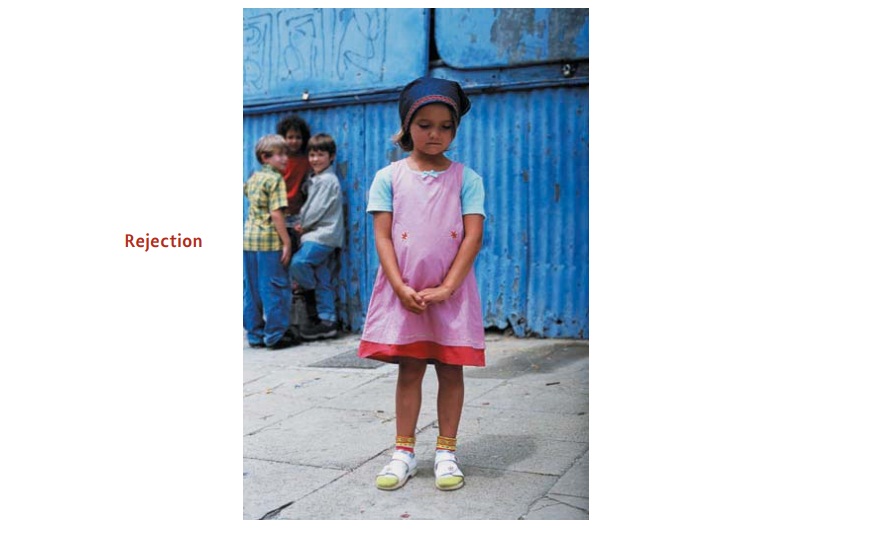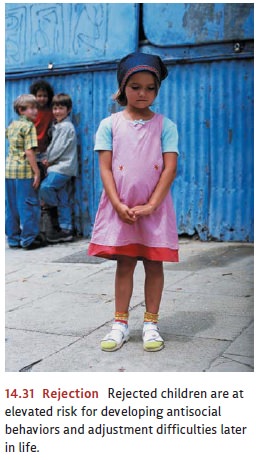Chapter: Psychology: Development
Peer Relationships - Socioemotional Development in Infancy and Childhood

PEER RELATIONSHIPS
So
far, we have emphasized the relationship between a child and her caregivers,
and for the first few years of life, this relationship is of paramount
importance in the child’s social world. As the child grows, however, her social
world broadens—to include other children in the home, playmates, and
classmates.
According
to some researchers, relationships with peers exert more influence on a child’s
development than does the child’s relationship with his parents (J. R. Harris,
1995, 1998, 2000; for contrary views, see Collins et al., 2000; Vandell, 2000).
On any account, though, peer relations shape each child in crucial ways. Let’s
examine these relations, focusing on friendship.
From
an early age, children prefer some of their peers over others, and by the time
they are 2 years old, they show the beginnings of friendship. They seek out
interactions with certain peers but avoid others. They display more positive
emotions with these peers than they do with other children. They are more
likely to imitate these peers and to cooperate with them than they are with others
(Howes, 1996; H. S. Ross & Lollis, 1989; Werebe & Baudonniere, 1991).
Of
course, as children grow, friendships change and develop. At age 6 or 7,
children tend to focus on what they gain from their friends: “He has great
toys”; “We can play together.” This perspective gradually changes, though, to
emphasize mutual liking, closeness, and loyalty (Berndt, 1996; Hartrup, 1996;
Newcomb & Bagwell, 1995), andby age 9 or so, children define friendship in
terms of taking care of one another, help-ing each other, and sharing feelings.
Friendships
are important for the child for many reasons. They provide the positive
experiences of shared play and shared activity. They also provide support in
times of stress, information in times of uncertainty, and a training ground in
which children can try out, and master, a variety of social skills. For
example, children need to learn to han-dle conflict, and much of this learning
takes place with friends. Friends quarrel, maybe even just as much as
nonfriends (Fabes, Eisenberg, Smith, & Murphy, 1996). But they find ways to
handle the conflict—through negotiation or cooperation—and are appre-ciably
more likely than nonfriends to continue their interactions after the conflict
is over. Having friends—and resolving conflicts with them—helps the child gain
skills for solving social problems (Rubin, Bukowski, & Parker, 1998).
Children
also learn valuable lessons from the candor and intimacy that friendship
allows. All kinds of social interactions require interpreting others’ thoughts
and emotional states, and one way for children to gain that skill is via
friendship. Friends dis-cuss their thoughts and feelings in ways that
nonfriends do not, and these conversations provide children with important
insights into the minds of others (C. Hughes & Dunn, 1998; Maguire &
Dunn, 1997).
Given
all these benefits, having friends is likely to help children both immediately
and in the long term. In fact, having close friends as a child is associated
with many positive outcomes, including social success later in life and greater
feelings of self-worth (Bagwell, Newcomb, & Bukowski, 1998; Hodges, Malone,
& Perry, 1997; D. Schwartz, Dodge, Pettit, Bates, & the Conduct
Problems Prevention Research Group, 2000). Children who enter kindergarten
along with friends seem to like school better and have fewer adjustment
problems, in comparison with children who enter kinder-garten without their
friends’ company (Ladd, Kochenderfer, & Coleman, 1996; Ladd & Price,
1987). Children with friends are also less likely to become depressed (Bagwell,
Newcomb, & Bukowski, 1998).
The
effects of friendship can also be documented in another way—by looking at
children who are rejected by their
peers. Investigators have explored this point by first gathering sociometric data—data that describe
group interactions—to determine which children are popular (liked by many),
which are rejected (disliked by many), and which are neglected by peers
(neither liked nor disliked). Often this determina-tion is made simply by
asking a group of children whom they like and whom they do not; a similar
determination can be reached by asking teachers which of their students are
accepted and which are not (Cillessen & Bukowski, 2000; Terry & Coie,
1991; Wu, Hart, Draper, & Olsen, 2001). No matter how this classification
is carried out, the picture is not bright for the rejected children. When
interviewed, rejected children report that they are lonely and, indeed,
lonelier than the neglected children (Cassidy & Asher, 1992; N. R .Crick
& Ladd, 1993). The rejected children are also the ones who are at greater
risk for developing antisocial behaviors or adjustment diffi-culties later in
life (Coie & Dodge, 1983; Dodge & Pettit, 2003; Laird, Jordan, Dodge,
Pettit, & Bates, 2001).
Why
does a specific child end up being popular or neglected or rejected (Figure
14.31)? Many factors contribute, including the child’s attachment status
(secure children tend to be popular) and the parenting style in the child’s
home (children with authoritative parents are more likely to be popular).
Temperament matters, as inhibited or slow-to-warm-up children are more likely
to be rejected (C. Hart, Newell, & Olsen, 2003). Appearances also matter,
making rejection less likely for children who have attractive faces (Langlois
et al., 2000) and attractive bodies (Sigelman, Miller, & Whitworth, 1986).
For boys, maturing early tends to promote popularity (Duke et al.,

1982;
Livson & Peskin, 1980); for girls, the opposite may be the case (Aro &
Taipale, 1987; Clausen, 1975).
Whatever
the causes of acceptance or rejection, this dimension of social status surely
does matter. We can debate which is the cause here and which is the effect, but
the data indicate that so-called aggressive-rejected
children are more aggressive (Crick, 1996), less cooperative (Newcomb,
Bukowski, & Pattee, 1993), and more likely to become chronically hostile in
adolescence and adulthood (J. Parker, Rubin, Price, & DeRosier, 1995; Rubin
et al., 1998). Withdrawn-rejected
children are likely to be anx-ious (Downey, Lebolt, Rincon, & Freitas,
1998; Zakriski & Coie, 1996) and are at increased risk for depression
(Hymel, Bowker, & Woody, 1993).
All
of these results speak to the importance and benefits of friendship and to the
difficulties associated with being rejected. But we should also note that
friends can influence each other negatively. Aggressive and disruptive friends
can teach this kind of behavior (Berndt, 1999; Brendgen, Vitaro, & Bukowski,
2000). Likewise, as we will see in the next section, adolescents are often led
into bad habits by their friends—including alcohol and substance abuse (Mounts
&Steinberg , 1995; Urberg , Degirmenciogl & Pilgrim, 1997). Friendships
are thus a double-edged sword, capable of conferring both great benefit and
lasting harm.
Related Topics